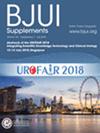肿瘤显微切割睾丸取精术(Onco-microTESE)对无精子症或严重少精子症睾丸癌患者保留生育能力的效果
IF 3.7
2区 医学
Q1 UROLOGY & NEPHROLOGY
引用次数: 0
摘要
目的确定肿瘤显微切割睾丸取精术(onco-microTESE)在无精子症和严重少精子症(OAT; <100万/毫升精子)睾丸癌(TC)患者中的成功率,并探讨可能预测成功率的任何因素。患者与方法2015年8月至2022年8月期间,在TC伴有严重OAT或无精子症的情况下,所有连续就诊或转诊至一家三级专科转诊中心进行生育管理的患者(38名患者的42个睾丸)的病例系列结果。收集了所有患者的生化、放射学和组织学参数。所有患者都接受了onco-microTESE(同时进行腹股沟根治性睾丸切除术和受影响睾丸的体外microTESE)。手术取精(SSR)失败的患者,如果没有禁忌症,则同时接受对侧显微睾丸取精术(microTESE)。主要结果是受影响睾丸的手术取精成功,足以用于辅助生殖技术。次要结果包括对侧显微睾丸切除术的成功率、从转诊到手术的时间以及总的成功生育率。在 8 名无精子症患者中,有 2 名患者的共侧显微精囊切除术失败,另外 2 名患者的共侧显微精囊切除术也获得了成功。总体而言,该系列中 22/31 例无精子症患者(71%)成功保留了生育能力。此外,七名重度OAT患者中有六名通过onco-microTESE进一步收获精子,以最大限度地保留生育能力。所有手术均在患者发病后 7(5-13)天的中位数(四分位数间距)内进行。了解首次就诊时的生育状况对于为 TC 患者提供额外的最佳生育力保留方案至关重要。本文章由计算机程序翻译,如有差异,请以英文原文为准。
Oncological microdissection testicular sperm extraction (Onco‐microTESE) outcomes for fertility preservation of patients with testicular cancer with azoospermia or severe oligoasthenoteratozoospermia
ObjectiveTo determine the success rate of oncological microdissection testicular sperm extraction (onco‐microTESE) in patients with testicular cancer (TC) with azoospermia and severe oligoasthenoteratozoospermia (OAT; <1 million/mL sperm) and to explore any factors that may predict success.Patients and MethodsCase series of outcomes from all consecutive patients (42 testes in 38 patients) that presented or were referred to a single specialist tertiary referral centre for fertility management in the context of TC with severe OAT or azoospermia between August 2015 and August 2022. Biochemical, radiological, and histological parameters were collected for all patients. All patients underwent onco‐microTESE (simultaneous radical inguinal orchidectomy with ex vivo microTESE of the affected testis). Those with unsuccessful surgical sperm retrieval (SSR) from the affected testis underwent contemporaneous contralateral microTESE, if no contraindication was present. The primary outcome was successful SSR from the affected testicle sufficient for assisted reproductive techniques. Secondary outcomes included contralateral microTESE success, the time from referral to procedure, and the total successful fertility preservation rate.ResultsInitial onco‐microTESE was successful in 19 of 31 patients (61%) with azoospermia. Contralateral microTESE was successful in a further two of eight patients with azoospermia with failed onco‐microTESE. Overall, 22/31 patients with azoospermia (71%) had successful fertility preservation in this series. In addition, six of seven patients with severe OAT had further sperm harvested by onco‐microTESE to maximise their fertility preservation. All surgery was performed within median (interquartile range) of 7 (5–13) days from presentation.ConclusionsOnco‐microTESE represents an effective method of fertility preservation for sub‐fertile patients with TC without delaying oncological treatment. Knowledge of the fertility status at first presentation is essential to allow for such additional options for optimal fertility preservation in TC.
求助全文
通过发布文献求助,成功后即可免费获取论文全文。
去求助
来源期刊

BJU International
医学-泌尿学与肾脏学
CiteScore
9.10
自引率
4.40%
发文量
262
审稿时长
1 months
期刊介绍:
BJUI is one of the most highly respected medical journals in the world, with a truly international range of published papers and appeal. Every issue gives invaluable practical information in the form of original articles, reviews, comments, surgical education articles, and translational science articles in the field of urology. BJUI employs topical sections, and is in full colour, making it easier to browse or search for something specific.
 求助内容:
求助内容: 应助结果提醒方式:
应助结果提醒方式:


